Water-Floating Hydrogel Polymer Microsphere Composites for Application in Hydrological Mining of Cu(II) Ions
Abstract
:1. Introduction
2. Materials and Methods
2.1. Materials
2.2. Synthesis and Functionalization of Silica Nanoparticles and Polymer Microspheres
2.3. Preparation of Hydrogel—Polymer Microspheres Composites
2.4. Measurement of Ion Extraction and Recovery Capacity of HPM Composite
2.5. Material Characterization
2.5.1. Scanning Electron Microscopy
2.5.2. Optical Microscopy
2.5.3. Contact Angle—Washburn Method
2.5.4. Penetration Experiments
3. Results and Discussion
3.1. Preparation via PEmPTech and Characterization of Polymer Microspheres
3.2. Preparation, Characterization, and Morphology of HPM Composites
3.3. Role of Morphology of the HPM Composites in Cu(II) Adsorption and Water-Floating Ability
3.4. Capacity of Ion Extraction and Recovery of HPM Composites
4. Conclusions
Supplementary Materials
Author Contributions
Funding
Data Availability Statement
Conflicts of Interest
References
- Dutta, D.; Arya, S.; Kumar, S. Industrial Wastewater Treatment: Current Trends, Bottlenecks, and Best Practices. Chemosphere 2021, 285, 131245. [Google Scholar] [CrossRef] [PubMed]
- Gadipelly, C.; Pérez-González, A.; Yadav, G.D.; Ortiz, I.; Ibáñez, R.; Rathod, V.K.; Marathe, K.V. Pharmaceutical Industry Wastewater: Review of the Technologies for Water Treatment and Reuse. Ind. Eng. Chem. Res. 2014, 53, 11571–11592. [Google Scholar] [CrossRef]
- Nnaji, C.O.; Jeevanandam, J.; Chan, Y.S.; Danquah, M.K.; Pan, S.; Barhoum, A. Chapter 6—Engineered Nanomaterials for Wastewater Treatment: Current and Future Trends. In Fundamentals of Nanoparticles; Barhoum, A., Hamdy Makhlouf, A.S., Eds.; Elsevier: Amsterdam, The Netherlands, 2018; pp. 129–168. ISBN 978-0-323-51255-8. [Google Scholar]
- Sharma, Y.C.; Srivastava, V.; Singh, V.K.; Kaul, S.N.; Weng, C.H. Nano-adsorbents for the Removal of Metallic Pollutants from Water and Wastewater. Environ. Technol. 2009, 30, 583–609. [Google Scholar] [CrossRef] [PubMed]
- Fu, F.; Wang, Q. Removal of Heavy Metal Ions from Wastewaters: A Review. J. Environ. Manag. 2011, 92, 407–418. [Google Scholar] [CrossRef]
- Al-Saydeh, S.A.; El-Naas, M.H.; Zaidi, S.J. Copper Removal from Industrial Wastewater: A Comprehensive Review. J. Ind. Eng. Chem. 2017, 56, 35–44. [Google Scholar] [CrossRef]
- Zhou, T.; Zhao, M.; Zhao, X.; Guo, Y.; Zhao, Y. Simultaneous Remediation and Fertility Improvement of Heavy Metals Contaminated Soil by a Novel Composite Hydrogel Synthesized from Food Waste. Chemosphere 2021, 275, 129984. [Google Scholar] [CrossRef]
- Andreazza, R.; Morales, A.; Pieniz, S.; Labidi, J. Gelatin-Based Hydrogels: Potential Biomaterials for Remediation. Polymers 2023, 15, 1026. [Google Scholar] [CrossRef]
- Wang, X. Nanomaterials as Sorbents to Remove Heavy Metal Ions in Wastewater Treatment. J. Environ. Anal. Toxicol. 2012, 2, 154–158. [Google Scholar] [CrossRef]
- Zhu, Y.; Wang, W.; Yu, H.; Wang, A. Preparation of Porous Adsorbent via Pickering Emulsion Template for Water Treatment: A Review. J. Environ. Sci. 2020, 88, 217–236. [Google Scholar] [CrossRef]
- Han, J.; Du, Z.; Zou, W.; Li, H.; Zhang, C. Fabrication of Interfacial Functionalized Porous Polymer Monolith and Its Adsorption Properties of Copper Ions. J. Hazard. Mater. 2014, 276, 225–231. [Google Scholar] [CrossRef]
- Shan, S.; Sun, X.-F.; Xie, Y.; Li, W.; Ji, T. High-Performance Hydrogel Adsorbent Based on Cellulose, Hemicellulose, and Lignin for Copper(II) Ion Removal. Polymers 2021, 13, 3063. [Google Scholar] [CrossRef] [PubMed]
- Wang, T.; An, Y.; Sun, J.; Yang, H.; Huang, Y.; Zheng, H. Hollow Self-Floating Microspheres Capture Cobalt (Co2+)/Nickel (Ni2+) Ions from the Acidic Leachate of Spent Lithium-Ion Battery Cathodes. Chem. Eng. J. 2023, 465, 142950. [Google Scholar] [CrossRef]
- Tang, Q.; Zhang, F.; Chen, W.; Ma, D.; Du, B.; Zhang, K.; Huang, X.; Luo, H.; Fan, L.; An, X.; et al. Floating-Separation Adsorbent for Methylene Blue and Pb(II) Removal: Structure Construction and Adsorption Mechanism. Sep. Purif. Technol. 2022, 295, 121332. [Google Scholar] [CrossRef]
- Li, S.; Li, Y.; Fu, Z.; Lu, L.; Cheng, J.; Fei, Y. A ‘Top Modification’ Strategy for Enhancing the Ability of a Chitosan Aerogel to Efficiently Capture Heavy Metal Ions. J. Colloid Interface Sci. 2021, 594, 141–149. [Google Scholar] [CrossRef] [PubMed]
- Mi, X.; Huang, G.; Xie, W.; Wang, W.; Liu, Y.; Gao, J. Preparation of Graphene Oxide Aerogel and Its Adsorption for Cu2+ Ions. Carbon 2012, 50, 4856–4864. [Google Scholar] [CrossRef]
- Bloor, J.M.; Handy, R.D.; Awan, S.A.; Jenkins, D.F.L. Graphene Oxide Biopolymer Aerogels for the Removal of Lead from Drinking Water Using a Novel Nano-Enhanced Ion Exchange Cascade. Ecotoxicol. Environ. Saf. 2021, 208, 111422. [Google Scholar] [CrossRef]
- Mir, N.; Castano, C.E.; Rojas, J.V.; Norouzi, N.; Esmaeili, A.R.; Mohammadi, R. Self-Separation of the Adsorbent after Recovery of Rare-Earth Metals: Designing a Novel Non-Wettable Polymer. Sep. Purif. Technol. 2021, 259, 118152. [Google Scholar] [CrossRef]
- Liu, R.; Yan, Q.; Tang, Y.; Liu, R.; Huang, L.; Shuai, Q. NaCl Template-Assisted Synthesis of Self-Floating COFs Foams for the Efficient Removal of Sulfamerazine. J. Hazard. Mater. 2022, 421, 126702. [Google Scholar] [CrossRef]
- Jing, G.; Wang, L.; Yu, H.; Amer, W.A.; Zhang, L. Recent Progress on Study of Hybrid Hydrogels for Water Treatment. Colloids Surf. A Physicochem. Eng. Asp. 2013, 416, 86–94. [Google Scholar] [CrossRef]
- Shalla, A.H.; Yaseen, Z.; Bhat, M.A.; Rangreez, T.A.; Maswal, M. Recent Review for Removal of Metal Ions by Hydrogels. Sep. Sci. Technol. 2019, 54, 89–100. [Google Scholar] [CrossRef]
- Honciuc, A.; Solonaru, A.-M.; Honciuc, M. Pickering Emulsion Polymerization Technology—Toward Nanostructured Materials for Applications in Metal Ion Extractions from Wastewaters. ACS Appl. Polym. Mater. 2023. [Google Scholar] [CrossRef]
- Honciuc, A.; Negru, O.-I. NanoTraPPED—A New Method for Determining the Surface Energy of Nanoparticles via Pickering Emulsion Polymerization. Nanomaterials 2021, 11, 3200. [Google Scholar] [CrossRef]
- Yang, J.; Li, Y.; Wang, J.; Sun, X.; Cao, R.; Sun, H.; Huang, C.; Chen, J. Molecularly Imprinted Polymer Microspheres Prepared by Pickering Emulsion Polymerization for Selective Solid-Phase Extraction of Eight Bisphenols from Human Urine Samples. Anal. Chim. Acta 2015, 872, 35–45. [Google Scholar] [CrossRef] [PubMed]
- Ma, H.; Luo, M.; Sanyal, S.; Rege, K.; Dai, L. The One-Step Pickering Emulsion Polymerization Route for Synthesizing Organic-Inorganic Nanocomposite Particles. Materials 2010, 3, 1186–1202. [Google Scholar] [CrossRef]
- Honciuc, A.; Negru, O.-I. Asymmetrically Nanostructured 2D Janus Films Obtained from Pickering Emulsions Polymerized in a Langmuir–Blodgett Trough. Micromachines 2023, 14, 1459. [Google Scholar] [CrossRef] [PubMed]
- Honciuc, A.; Negru, O.-I. Role of Surface Energy of Nanoparticle Stabilizers in the Synthesis of Microspheres via Pickering Emulsion Polymerization. Nanomaterials 2022, 12, 995. [Google Scholar] [CrossRef] [PubMed]
- Honciuc, A. Chemistry of Functional Materials Surfaces and Interfaces: Fundamentals and Applications, 1st ed.; Elsevier: Amsterdam, The Netherlands, 2021; ISBN 978-0-12-821059-8. [Google Scholar]
- Kirdponpattara, S.; Phisalaphong, M.; Newby, B.Z. Applicability of Washburn Capillary Rise for Determining Contact Angles of Powders/Porous Materials. J. Colloid Interface Sci. 2013, 397, 169–176. [Google Scholar] [CrossRef]
- Wu, K.H.; Wang, Y.R.; Hwu, W.H. FTIR and TGA Studies of Poly(4-Vinylpyridine-Co-Divinylbenzene)–Cu(II) Complex. Polym. Degrad. Stab. 2003, 79, 195–200. [Google Scholar] [CrossRef]
- Lee, J.Y.; Painter, P.C.; Coleman, M.M. Hydrogen Bonding in Polymer Blends. 4. Blends Involving Polymers Containing Methacrylic Acid and Vinylpyridine Groups. Macromolecules 1988, 21, 954–960. [Google Scholar] [CrossRef]
- Zhou, X.; Goh, S.H.; Lee, S.Y.; Tan, K.L. XPS and FTi.r. Studies of Interactions in Poly(Carboxylic Acid)/Poly(Vinylpyridine) Complexes. Polymer 1998, 39, 3631–3640. [Google Scholar] [CrossRef]
- Inai, Y.; Kato, S.-I.; Hirabayashi, T.; Yokota, K. Complexation of Sequence-Ordered Methacrylic Acid Copolymers with Poly(4-Vinylpyridine). J. Polym. Sci. A Polym. Chem. 1996, 34, 2341–2348. [Google Scholar] [CrossRef]
- Morán-Quiroz, J.L.; Orozco-Guareño, E.; Manríquez, R.; Carbajal-Arízaga, G.G.; de la Cruz, W.; Gomez-Salazar, S. Polymeric Hydrogels Obtained Using a Redox Initiator: Application in Cu(II) Ions Removal from Aqueous Solutions. J. Appl. Polym. Sci. 2014, 131, 39933. [Google Scholar] [CrossRef]
- Milosavljević, N.; Debeljković, A.; Krušić, M.K.; Milašinović, N.; Üzüm, Ö.B.; Karadağ, E. Application of Poly(Acrlymide-Co-Sodium Methacrylate) Hydrogels in Copper and Cadmium Removal from Aqueous Solution. Environ. Prog. Sustain. Energy 2014, 33, 824–834. [Google Scholar] [CrossRef]
- Kaşgöz, H.; Durmuş, A.; Kaşgöz, A. Enhanced Swelling and Adsorption Properties of AAm-AMPSNa/Clay Hydrogel Nanocomposites for Heavy Metal Ion Removal. Polym. Adv. Technol. 2008, 19, 213–220. [Google Scholar] [CrossRef]
- Choi, J.-W.; Kim, H.J.; Ryu, H.; Oh, S.; Choi, S.-J. Three-Dimensional Double-Network Hydrogels of Graphene Oxide, Alginate, and Polyacrylonitrile for Copper Removal from Aqueous Solution. Environ. Eng. Res. 2019, 25, 924–929. [Google Scholar] [CrossRef]
- Revellame, E.D.; Fortela, D.L.; Sharp, W.; Hernandez, R.; Zappi, M.E. Adsorption Kinetic Modeling Using Pseudo-First Order and Pseudo-Second Order Rate Laws: A Review. Clean. Eng. Technol. 2020, 1, 100032. [Google Scholar] [CrossRef]
- Yan, H.; Dai, J.; Yang, Z.; Yang, H.; Cheng, R. Enhanced and Selective Adsorption of Copper(II) Ions on Surface Carboxymethylated Chitosan Hydrogel Beads. Chem. Eng. J. 2011, 174, 586–594. [Google Scholar] [CrossRef]
- Ho, Y.S.; McKay, G. Pseudo-Second Order Model for Sorption Processes. Process Biochem. 1999, 34, 451–465. [Google Scholar] [CrossRef]
- Heller, M.I.; Croot, P.L. Copper Speciation and Distribution in the Atlantic Sector of the Southern Ocean. Mar. Chem. 2015, 173, 253–268. [Google Scholar] [CrossRef]
- Karavoltsos, S.; Kalambokis, E.; Sakellari, A.; Plavšić, M.; Dotsika, E.; Karalis, P.; Leondiadis, L.; Dassenakis, M.; Scoullos, M. Organic Matter Characterization and Copper Complexing Capacity in the Sea Surface Microlayer of Coastal Areas of the Eastern Mediterranean. Mar. Chem. 2015, 173, 234–243. [Google Scholar] [CrossRef]
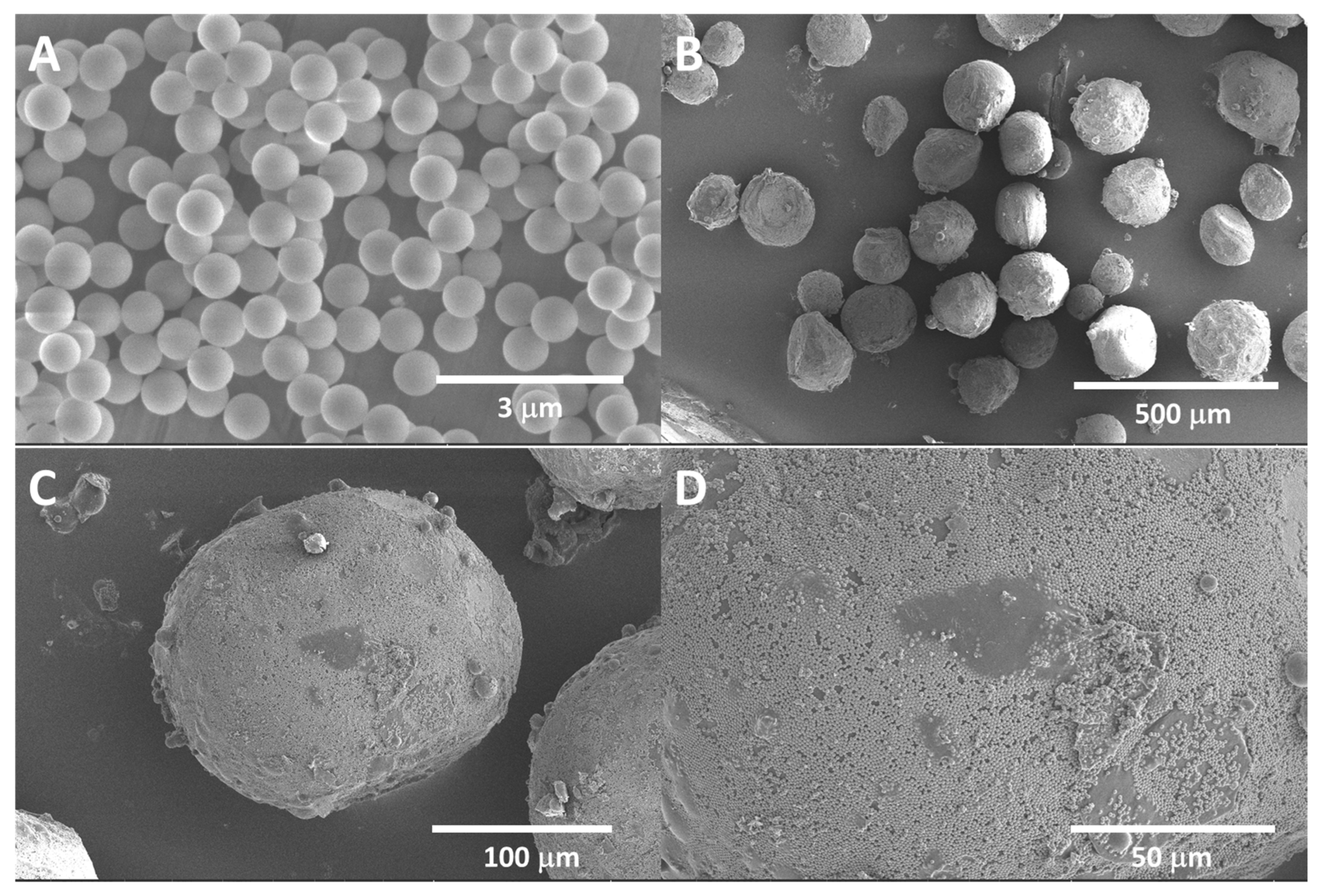

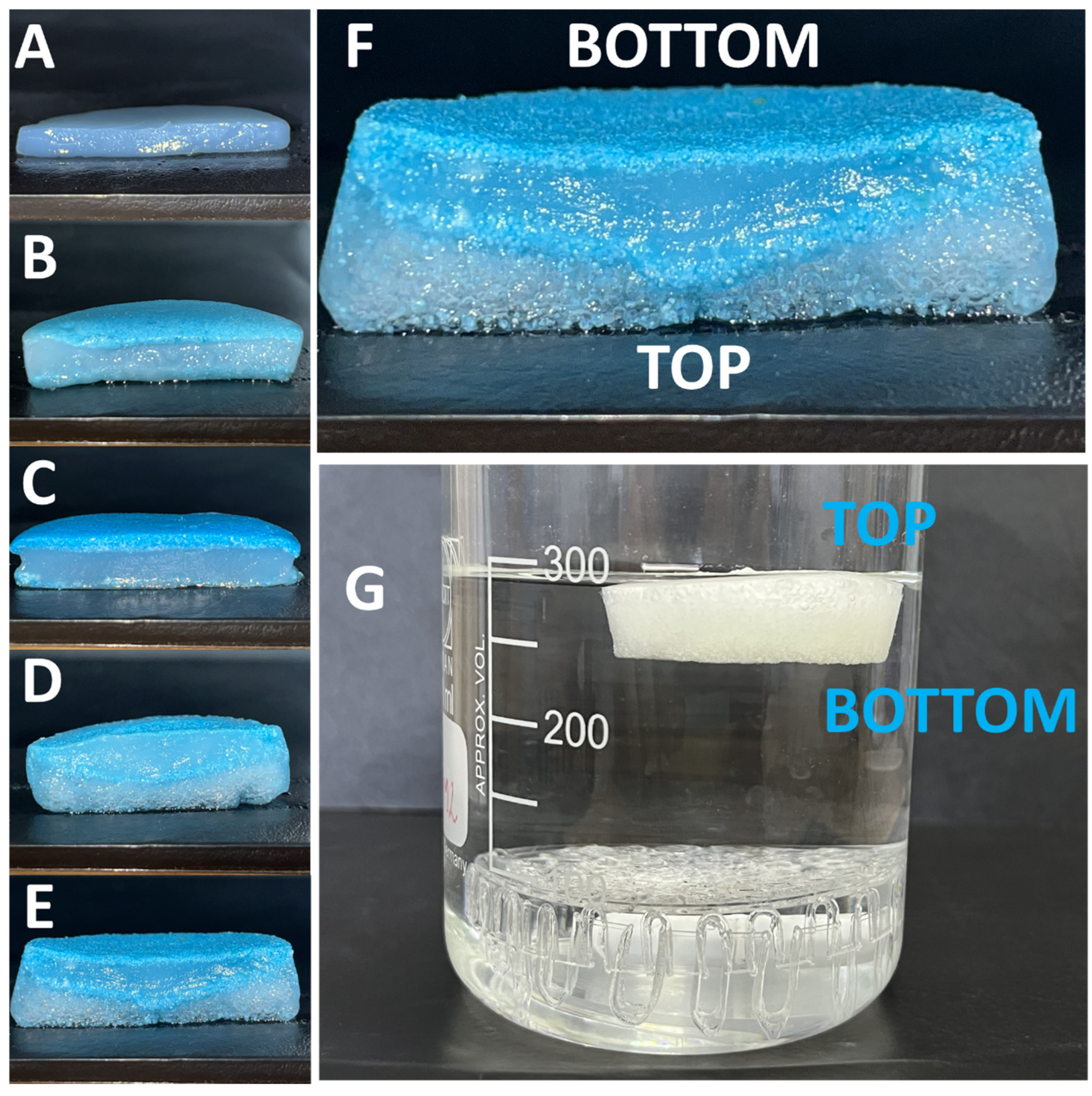
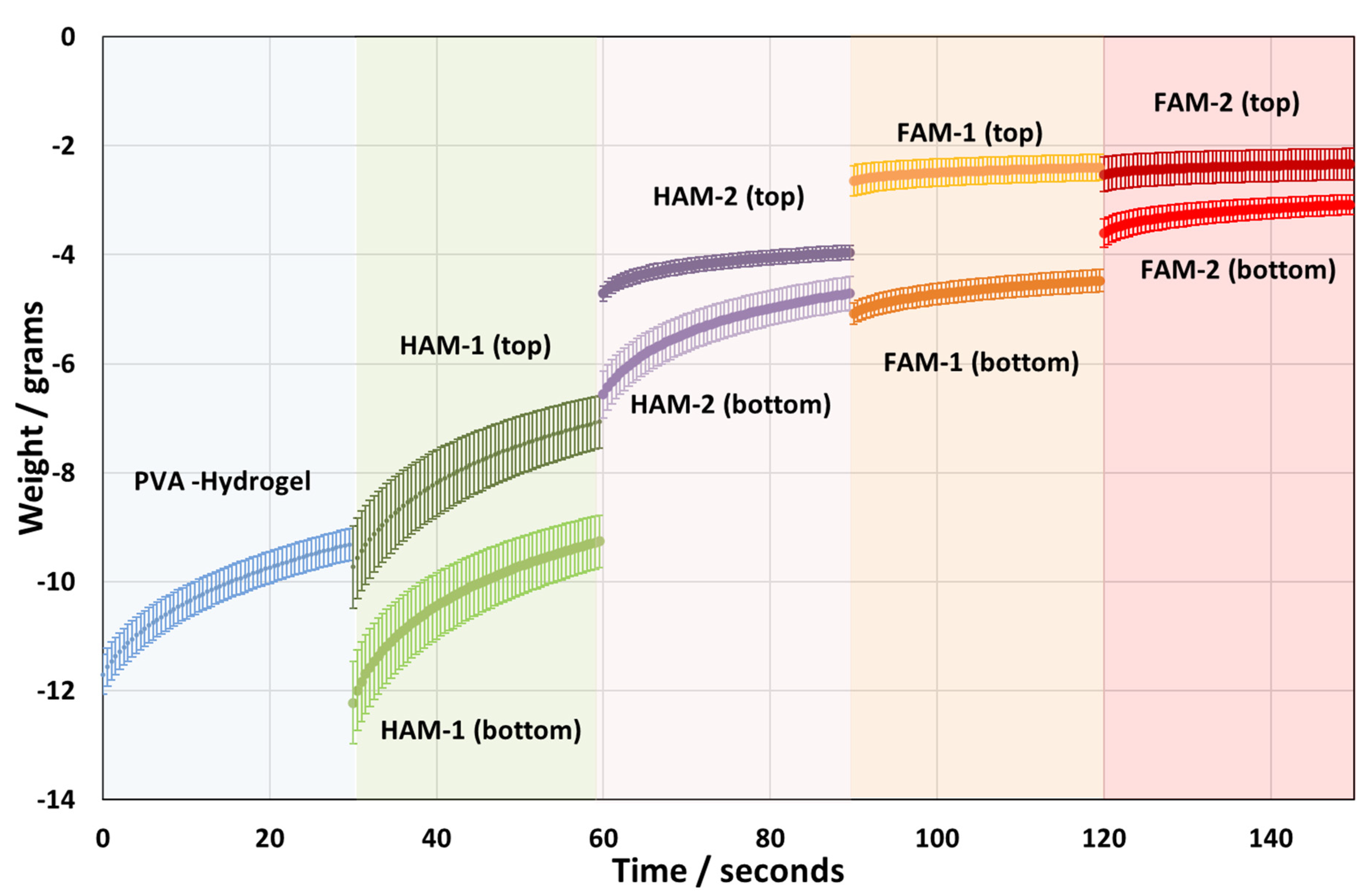
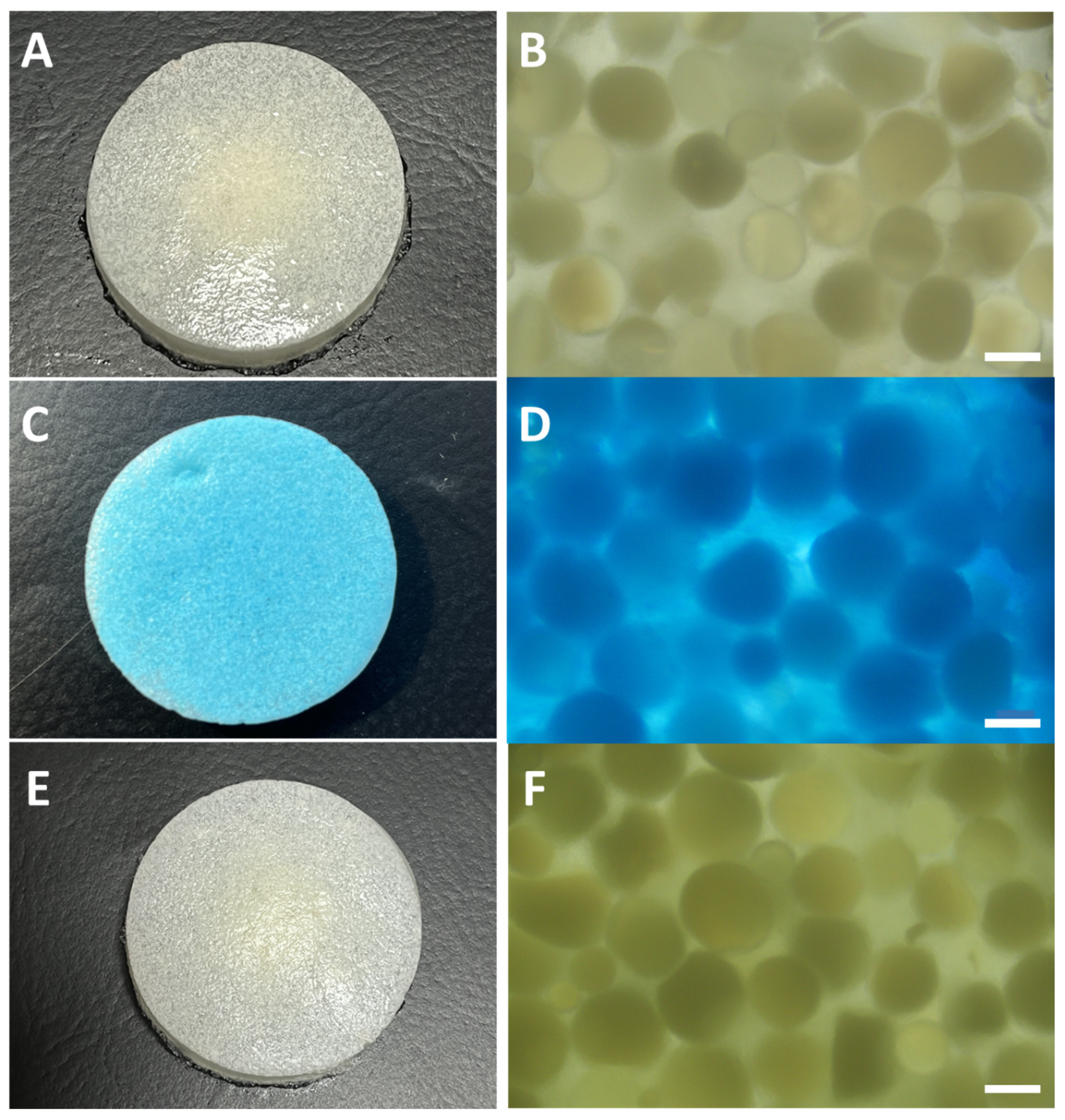
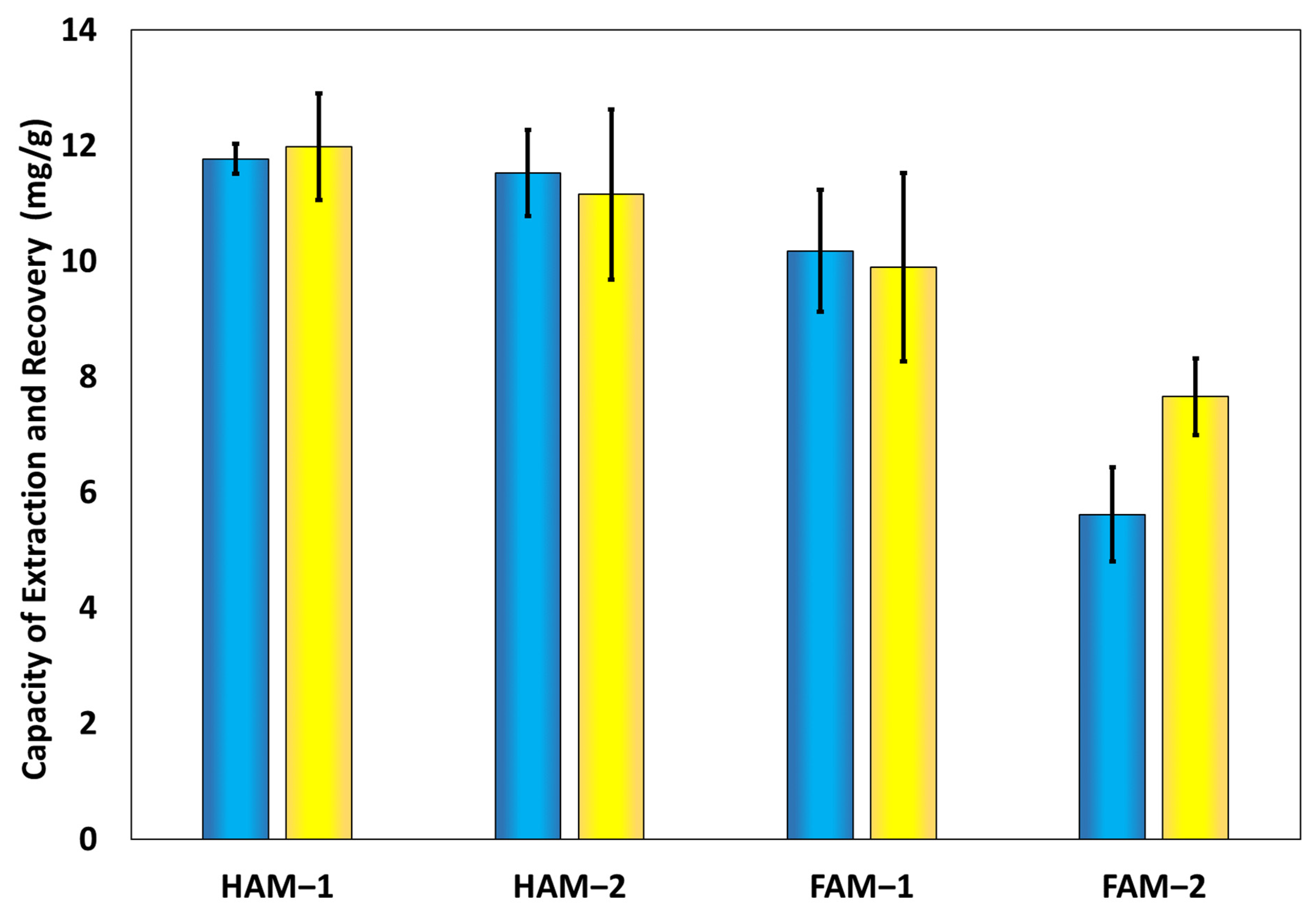
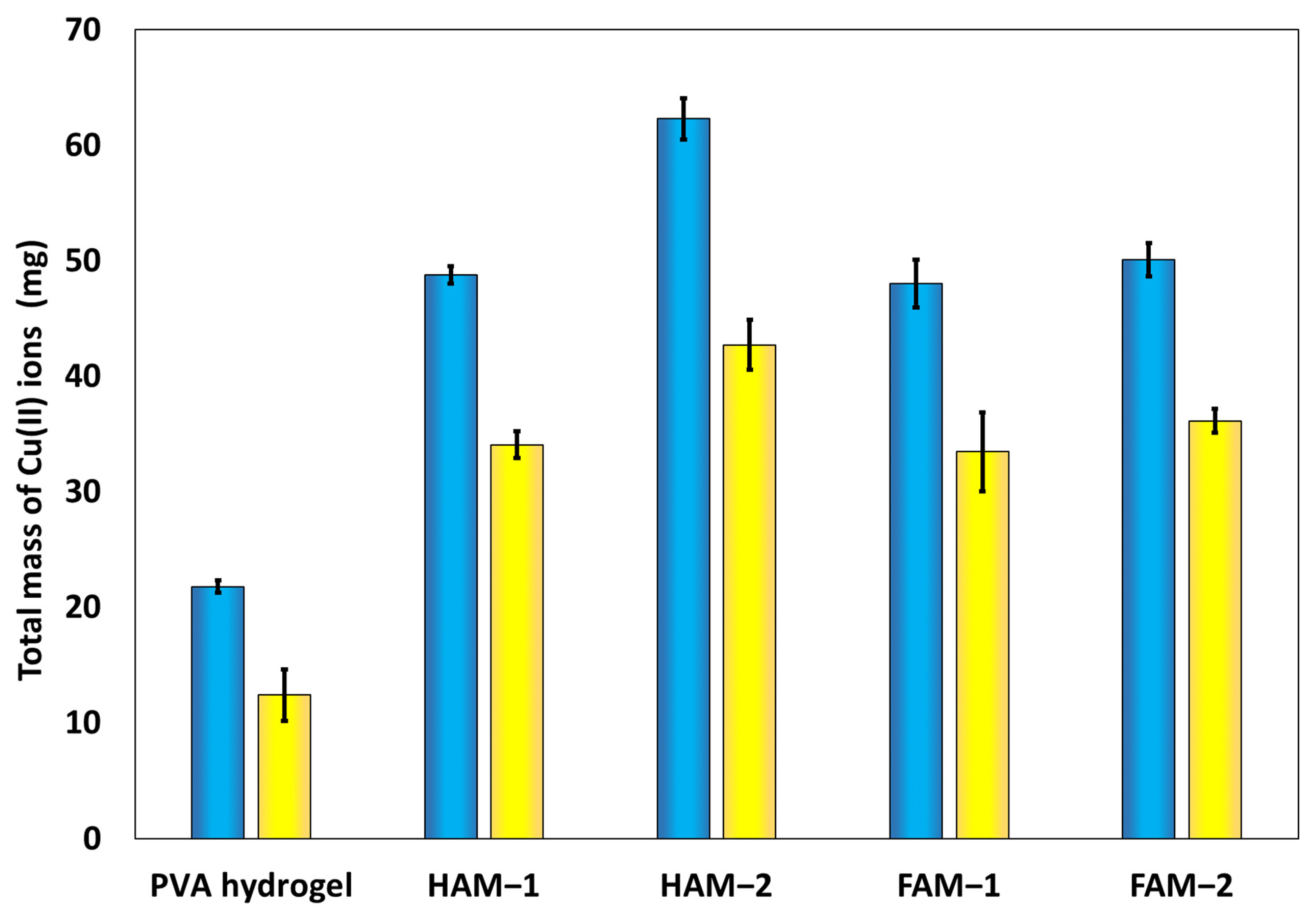
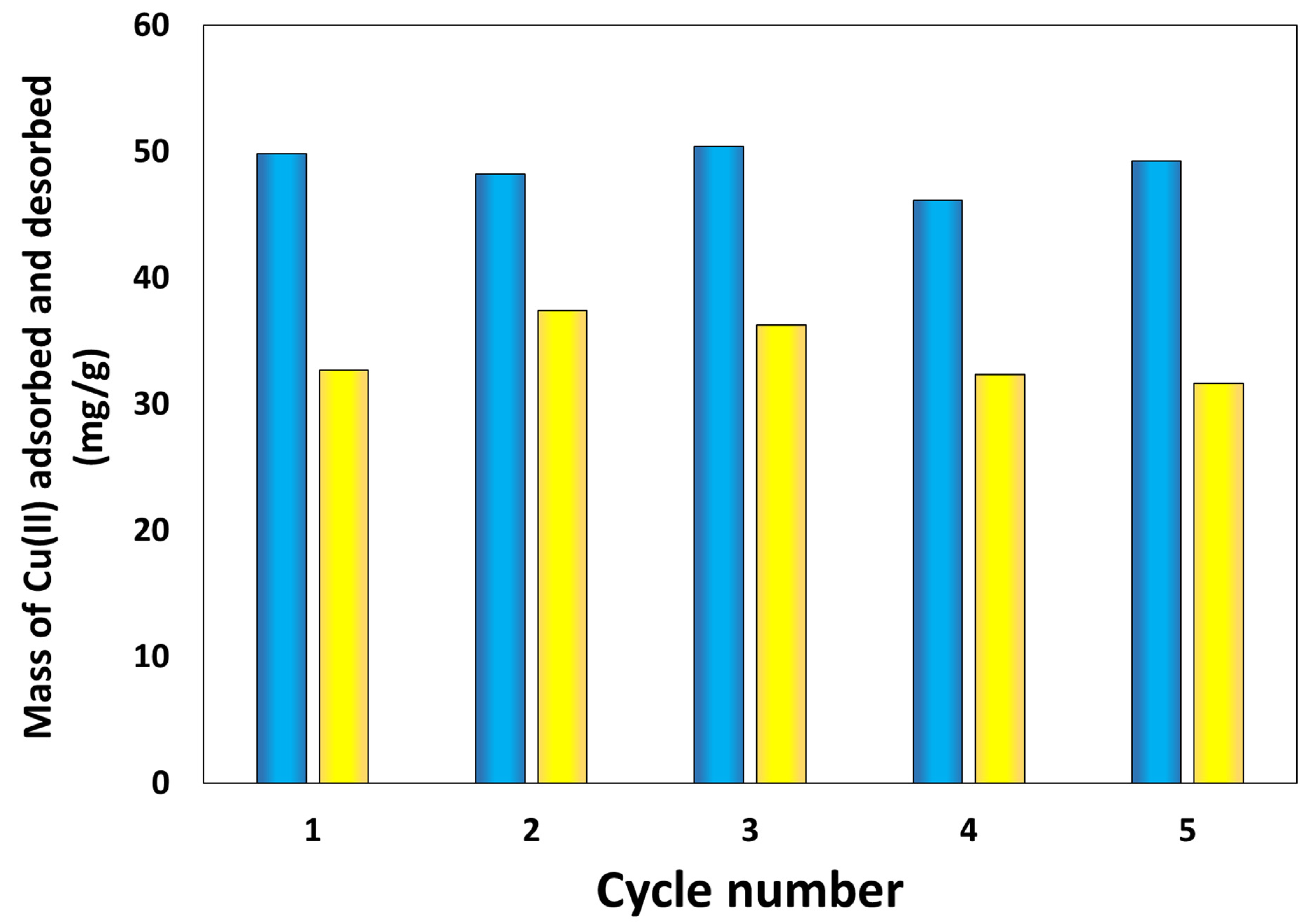
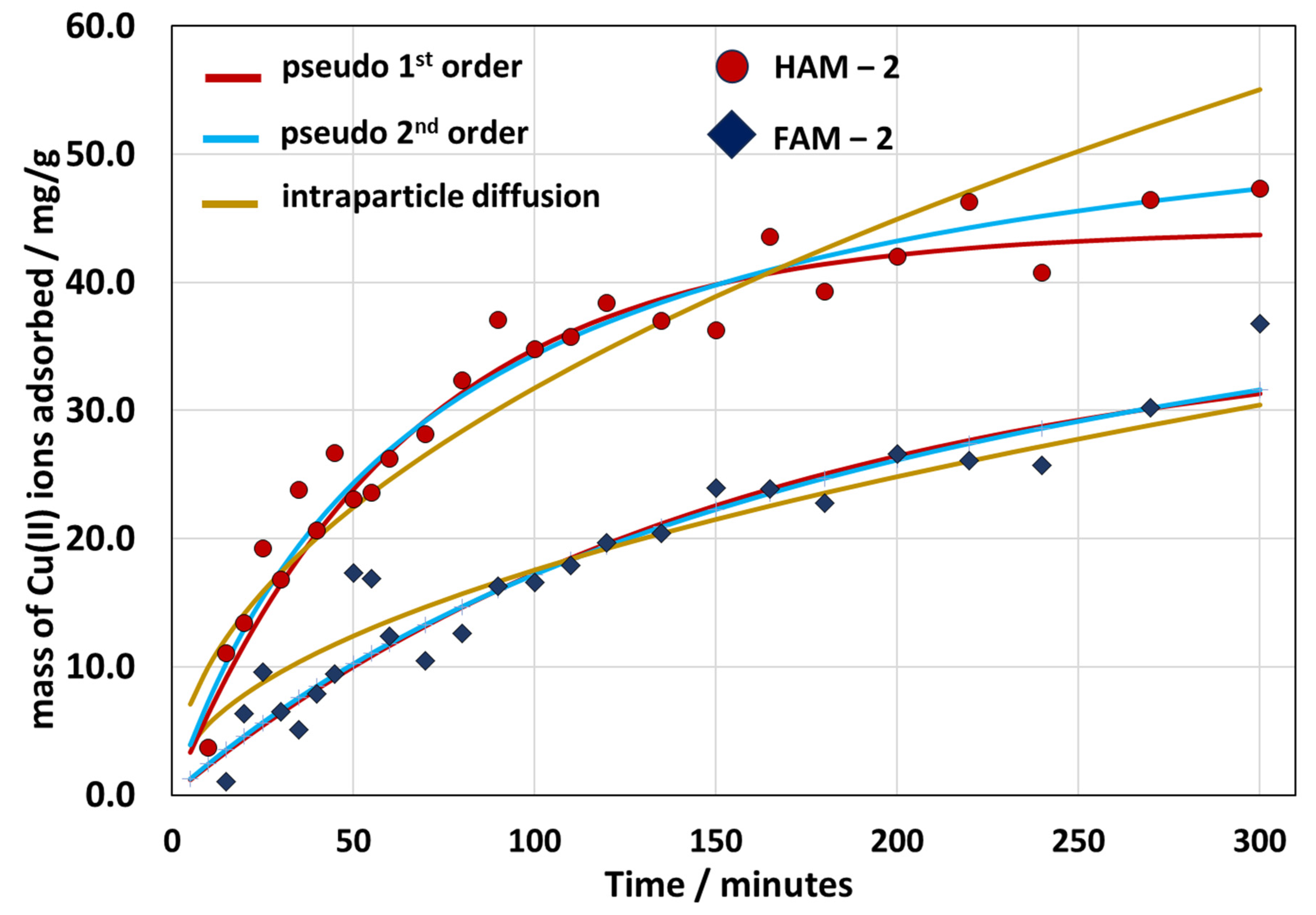
Disclaimer/Publisher’s Note: The statements, opinions and data contained in all publications are solely those of the individual author(s) and contributor(s) and not of MDPI and/or the editor(s). MDPI and/or the editor(s) disclaim responsibility for any injury to people or property resulting from any ideas, methods, instructions or products referred to in the content. |
© 2023 by the authors. Licensee MDPI, Basel, Switzerland. This article is an open access article distributed under the terms and conditions of the Creative Commons Attribution (CC BY) license (https://creativecommons.org/licenses/by/4.0/).
Share and Cite
Honciuc, A.; Solonaru, A.-M.; Honciuc, M. Water-Floating Hydrogel Polymer Microsphere Composites for Application in Hydrological Mining of Cu(II) Ions. Nanomaterials 2023, 13, 2619. https://doi.org/10.3390/nano13192619
Honciuc A, Solonaru A-M, Honciuc M. Water-Floating Hydrogel Polymer Microsphere Composites for Application in Hydrological Mining of Cu(II) Ions. Nanomaterials. 2023; 13(19):2619. https://doi.org/10.3390/nano13192619
Chicago/Turabian StyleHonciuc, Andrei, Ana-Maria Solonaru, and Mirela Honciuc. 2023. "Water-Floating Hydrogel Polymer Microsphere Composites for Application in Hydrological Mining of Cu(II) Ions" Nanomaterials 13, no. 19: 2619. https://doi.org/10.3390/nano13192619
APA StyleHonciuc, A., Solonaru, A.-M., & Honciuc, M. (2023). Water-Floating Hydrogel Polymer Microsphere Composites for Application in Hydrological Mining of Cu(II) Ions. Nanomaterials, 13(19), 2619. https://doi.org/10.3390/nano13192619







